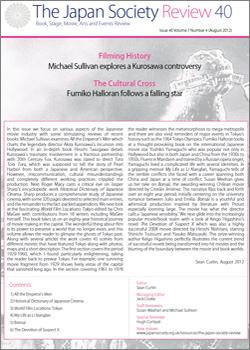Issue 40 (August 2012, Volume 7, Number 4)

In this issue we focus on various aspects of the Japanese movie industry with some stimulating reviews of recent books.
Michael Sullivan examines All the Emperor’s Men which charts the legendary director Akira Kurosawa’s incursion into Hollywood. In an in-depth book Hiroshi Tasogawa details Kurosawa’s traumatic involvement in a fractious partnership with 20th Century Fox. Kurosawa was slated to direct Tora Tora Tora, which was supposed to tell the story of Pearl Harbor from both a Japanese and American perspective. However, miscommunication, cultural misunderstandings and completely different working practices crippled the production.
Next Roger Macy casts a critical eye on Jasper Sharp’s encyclopedic work Historical Dictionary of Japanese Cinema. Sharp produces a comprehensive study of Japanese cinema, with some 320 pages devoted to selected main entries, and the remainder to the fact-packed appendices.
We next look at the fascinating World Film Locations: Tokyo edited by Chris MaGee with contributions from 18 writers including MaGee himself. This book takes us on an eighty-year historical journey of movie making in the capital. The wonderful thing about film is its power to preserve a world that no longer exists and this volume allows the reader to glimpse the ghosts of Tokyo past. Along with several articles the work covers 45 scenes from different movies that have featured Tokyo along with photos, maps and a short description. The first section covers the period 1929-1960, which I found particularly enlightening, taking the reader back to prewar Tokyo. For example, one surviving movie fragment from 1929 shows lively vistas of the capital that vanished long ago. In the section covering 1961 to 1978 the reader witnesses the metamorphosis to mega-metropolis and there are also vivid reminders of major events in Tokyo’s history such as the 1964 Tokyo Olympics.
Fumiko Halloran looks at a thought-provoking book on the international Japanese movie star Yoshiko Yamaguchi who was popular not only in Hollywood but also in both Japan and China from the 1930s to 1950s. Fluent in Mandarin and trained by a Russian opera singer, Yamaguchi lived a complicated life with several identities. In a gripping memoir My Life as Li Xianglan, Yamaguchi tells of the terrible conflicts she faced with a career spanning both China and Japan at a time of conflict.
Susan Meehan gives us her take on Bonsái, the awarding-winning Chilean movie directed by Cristián Jiménez. The narrative flips back and forth over an eight year period; initially centering on the university romance between Julio and Emilia. Bonsái is a youthful and whimsical production inspired by literature with Proust especially looming large. The movie has what the director calls a ‘Japanese sensibility.’
We next glide into the increasingly popular movie/book realm with a look at Keigo Higashino’s novel The Devotion of Suspect X which was also a highly successful 2008 movie directed by Hiroshi Nishitani, starring Shinichi Tsutsumi and Yasuko Matsuyuki. The prize-winning author Keigo Higashino perfectly illustrates the current trend of successful novels being transformed into hit movies and the blurring of the boundary between the movie and book worlds.
Contents
- All the Emperor’s Men
- Historical Dictionary of Japanese Cinema
- World Film Locations: Tokyo
- My Life as Li Xianglan
- Bonsai
- The Devotion of Suspect X
Contributors
Editor
Sean Curtin
Managing Editor
Jack Cooke
Staff Reviewers
Susan Meehan and Michael Sullivan
Special Reviewer
Hugh Cortazzi
Reviewers
Roger Macy and Fumiko Halloran

